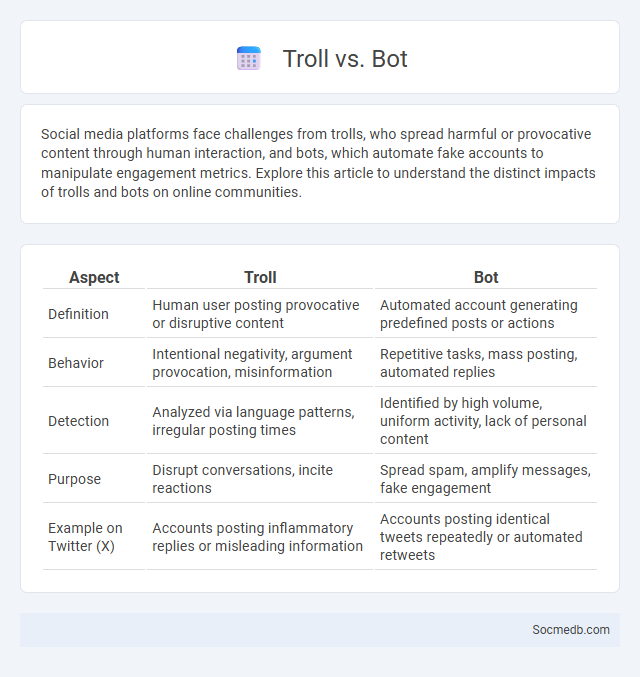
Photo illustration: Troll vs Bot
Social media platforms face challenges from trolls, who spread harmful or provocative content through human interaction, and bots, which automate fake accounts to manipulate engagement metrics. Explore this article to understand the distinct impacts of trolls and bots on online communities.
Table of Comparison
| Aspect | Troll | Bot |
|---|---|---|
| Definition | Human user posting provocative or disruptive content | Automated account generating predefined posts or actions |
| Behavior | Intentional negativity, argument provocation, misinformation | Repetitive tasks, mass posting, automated replies |
| Detection | Analyzed via language patterns, irregular posting times | Identified by high volume, uniform activity, lack of personal content |
| Purpose | Disrupt conversations, incite reactions | Spread spam, amplify messages, fake engagement |
| Example on Twitter (X) | Accounts posting inflammatory replies or misleading information | Accounts posting identical tweets repeatedly or automated retweets |
Understanding Trolls: Definition and Characteristics
Trolls are individuals who deliberately provoke, disrupt, or harass others on social media platforms, often by posting inflammatory, off-topic, or controversial messages. Their primary characteristics include anonymity, persistence, and a desire to elicit emotional responses or chaos within online communities. Understanding these traits helps you recognize and effectively handle trolling behavior to maintain a positive digital environment.
What is a Bot? Key Features and Functions
A bot is an automated software application designed to perform tasks on social media platforms, such as posting content, liking posts, and interacting with users, without human intervention. Key features include the ability to mimic human behavior, manage multiple accounts simultaneously, and analyze data to optimize engagement. Functions of bots range from customer service chat interactions and content distribution to automated responses and follower growth strategies.
Trolls vs Bots: Fundamental Differences
Trolls are individuals who intentionally provoke and harass users on social media through inflammatory or disruptive comments, while bots are automated programs designed to mimic human activity and amplify messages. Understanding these fundamental differences helps you identify genuine user interactions versus algorithm-driven manipulation. Detecting trolls often involves recognizing emotionally charged or offensive language, whereas spotting bots relies on analyzing repetitive behavior and unnatural posting patterns.
Types of Trolls and Their Online Behavior
Trolls on social media manifest in various types, including flame trolls who provoke heated arguments, impersonators who spread misinformation by posing as others, and baiters who incite emotional responses to disrupt conversations. These trolls often exploit anonymity and platform algorithms to amplify negativity and polarize communities. Understanding these behaviors helps you recognize and mitigate their impact on your online interactions.
Types of Bots: From Chatbots to Spam Bots
Social media platforms host various types of bots, including chatbots designed to interact with users and provide customer support, as well as spam bots that flood feeds with unsolicited content. These automated programs can significantly influence user experience by either enhancing engagement or causing disruptions. Understanding the differences between chatbots and spam bots helps you manage your social media presence effectively and avoid potential pitfalls.
Motivations Behind Trolling and Bot Use
Trolling and bot use on social media stem from motivations such as spreading misinformation, influencing public opinion, and disrupting online communities. Users often engage in trolling to provoke emotional reactions or to assert dominance within digital spaces, while bots automate these efforts on a larger scale for political or commercial gain. Understanding these drivers helps in developing targeted strategies to detect and mitigate harmful online behavior.
How to Identify Trolls in Online Communities
Recognizing trolls in online communities involves spotting users who provoke others by posting inflammatory, irrelevant, or offensive comments with the intent to disrupt conversations. Trolls often use exaggerated language, personal attacks, and persistent negativity that derail productive discussions. You can protect your online experience by ignoring such behavior and reporting repeat offenders to maintain a healthy, respectful community environment.
Spotting Bots: Signs and Tactics
Spotting bots on social media involves identifying patterns such as repetitive posting, unusually high activity levels, and generic or irrelevant comments that lack genuine engagement. Tactics include analyzing account metadata, follower growth rates, and interaction anomalies using advanced algorithms or bot detection tools to differentiate automated behavior from human users. Effective bot spotting enhances platform integrity by reducing misinformation, spam, and fraudulent interactions.
Impact on Online Communities: Trolls vs Bots
Trolls provoke emotional responses by spreading misinformation and harassment, disrupting online community trust and engagement. Bots amplify message reach, often promoting agendas or manipulating public opinion through automated accounts. Both entities degrade authentic interactions, challenging platform moderators in maintaining safe and reliable online environments.
Strategies for Dealing with Trolls and Bots
Effective strategies for dealing with trolls and bots on social media include implementing robust moderation tools that automatically detect and filter harmful content using AI-powered algorithms. Engaging community guidelines that clearly define acceptable behavior help reduce trolling by promoting respectful interactions among users. Continuous monitoring paired with user reporting mechanisms enhances the identification and swift removal of automated bots, maintaining authentic engagement on the platform.
 socmedb.com
socmedb.com